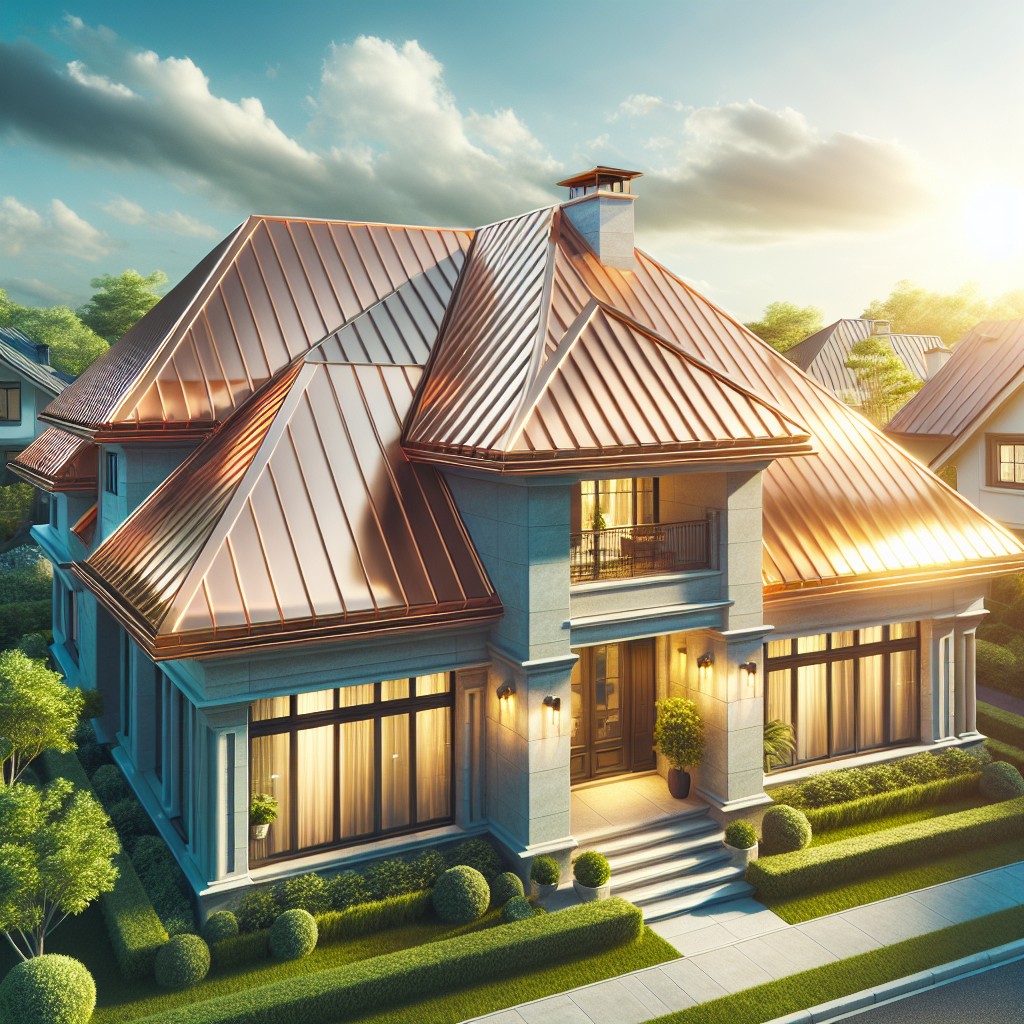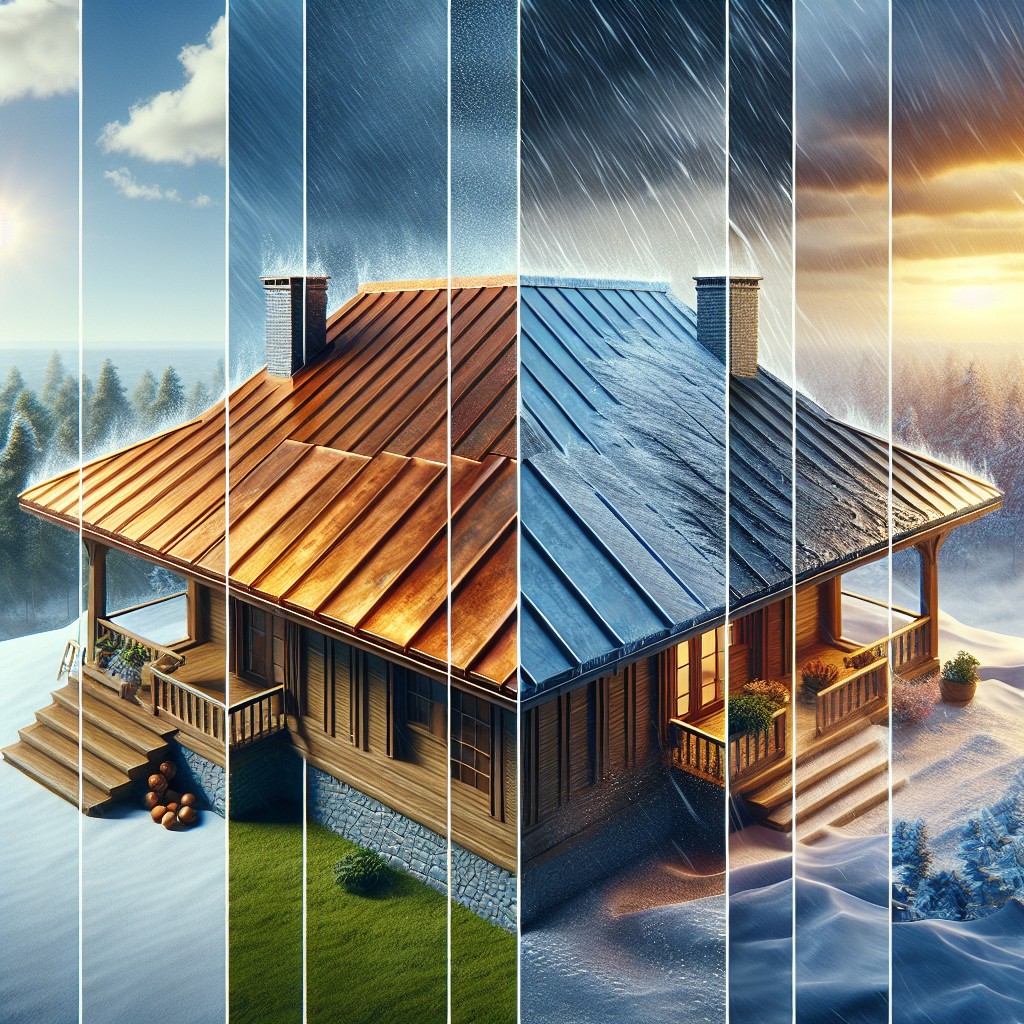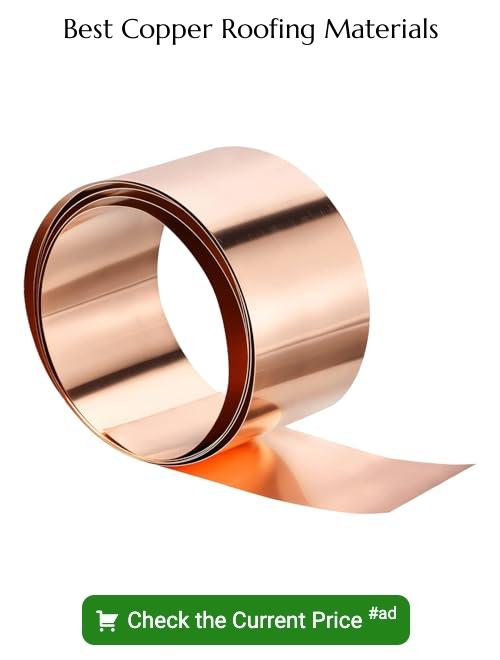Last updated on
Explore the multifaceted benefits of copper roofing because this material may offer more advantages than you think, from beauty and longevity to sustainability.
Key takeaways:
- Copper roofs can last over 50 years.
- Copper roofing is energy efficient and insulates well.
- Copper roofs develop a unique green patina over time.
- Copper roofs are highly resistant to hail, wind, and fire.
- Copper roofs require minimal upkeep and maintenance.
The Benefits

Copper’s remarkable longevity stems not only from its inherent strength but also from its ability to develop a protective patina over time. This layer essentially shields the material from various elements, significantly extending its lifespan, often exceeding fifty years. Its robustness means it holds up well against physical impact, and unlike some other materials, it’s not prone to rot or mold.
With an innate ability to reflect light rather than absorb it, copper roofing contributes to improved energy efficiency. This characteristic can help maintain lower temperatures within a building during warmer months. Come winter, copper’s superior insulation properties can reduce the heat loss typical of many other roofing materials.
The initial luster of a new copper roof is undoubtedly striking, but as the material ages, it takes on a unique greenish hue, known as verdigris, which many find visually appealing. This patina process not only contributes to the distinctive look but also serves as an additional protective layer.
In areas prone to adverse weather, copper roofs are particularly beneficial due to their high resistance to hail, wind, and fire. Their resilience in stormy conditions often translates to less frequent roofing repairs or replacements.
Furthermore, copper roofing necessitates minimal upkeep. It does not require painting or finishing and is not plagued by common roofing issues like insects or fungus.
Its eco-friendliness is twofold: copper is recyclable, reducing the waste associated with roof replacement, and because of its long life, the need for frequent material turnover is lessened.
Lastly, while the upfront cost of a copper roof may be higher than that of other materials, its enduring nature, coupled with low maintenance and energy efficiency, can lead to substantial savings over time. Its elegant appearance can also enhance property value, making it a financially sound choice in the long run.
Longevity and Durability

Copper boasts a formidable lifespan that can exceed 50 years, even under adverse environmental conditions. Its innate strength helps resist physical impact and mitigates the likelihood of damage from hail or fallen debris.
The metal’s natural resistance to corrosion ensures that it remains structurally sound as it develops a protective patina over time. This characteristic patina not only contributes to copper’s iconic appearance but also acts as a barrier against further elemental wear.
Additionally, copper’s durability eliminates the need for frequent replacements, making it an ideal roofing material for structures intended to last several generations.
Energy Efficiency and Insulation Properties
Copper roofing materials naturally reflect light rather than absorbing heat, contributing to a reduction in the cooling costs during sunny months. The metal’s insulation capability also helps to keep heat from escaping during colder times, ensuring consistent indoor temperatures year-round. This inherent property can help homeowners save on energy bills while contributing to a more comfortable living environment.
Additionally, copper can be installed with additional insulation to enhance its energy-saving potential. The combination of copper’s reflective quality and supplementary insulation forms a robust barrier against thermal transfer, further optimizing a home’s energy use.
Moreover, over time, copper develops a patina that not only adds visual character but also enhances the roof’s protective qualities, potentially increasing its energy efficiency. This natural oxidation process does not compromise the metal’s insulation attributes, assuring maintained performance throughout the roof’s lifespan.
Aesthetic Appeal
Copper roofing stands out for its classic elegance, capable of bestowing a touch of sophistication on various architectural designs. Initially showcasing a bright metallic sheen, it gracefully weathers into a verdigris patina, offering a dynamic range of hues over time.
This natural progression means that copper roofs integrate seamlessly with their surroundings, often enhancing the property’s visual appeal and potentially increasing its market value. Their distinctive character is not only a testament to taste but also adds to the building’s uniqueness, ensuring it doesn’t fade into the backdrop of cookie-cutter structures.
Weather Resistance
Copper roofs boast a remarkable ability to withstand various weather conditions. Their resilience is especially pronounced in coastal areas, where the metal naturally resists saltwater corrosion.
In snowy regions, copper’s low friction surface discourages snow accumulation, allowing it to slide off easily and prevent heavy snow loads.
Additionally, with a high thermal expansion coefficient, copper responds well to thermal changes without warping or cracking. This adaptability ensures that copper roofing remains structurally sound and aesthetically pleasing despite the rigors of the changing seasons.
Low Maintenance Requirements
Copper roofing stands out for requiring minimal upkeep due to its natural ability to resist various elements that often necessitate repairs for other materials. Its resilience means that issues like moss and fungal growths, which typically demand regular cleaning, rarely pose a problem.
Additionally, copper’s inherent strength fends off the need for frequent repairs or replacements that might stem from damage inflicted by severe weather events or debris.
Homeowners enjoy the freedom from persistent maintenance schedules since copper doesn’t require painting or finishing to sustain its protective qualities or aesthetic. The material forms a protective patina over time, which acts as a shield against corrosion, further solidifying its status as a low-upkeep option.
This characteristic of self-protection ensures that the roof remains robust and functional for several decades with little to no intervention beyond routine inspections.
Environmental Sustainability
Copper roofing is a green choice for several compelling reasons. First, it’s highly recyclable; almost all copper roofing material comes from recycled sources. This reduces the demand for copper mining and the associated environmental impact. Second, at the end of its long life span, a copper roof can be fully recycled, minimizing landfill waste. Lastly, copper roofs contribute to sustainable building trends by potentially earning points under green building standards like LEED (Leadership in Energy and Environmental Design). These attributes make copper an environmentally conscious material for homeowners and developers looking to reduce their ecological footprint.
Long-Term Cost-Effectiveness
Investing in copper roofing initially involves a higher upfront cost compared to more conventional materials. However, the extended lifespan of copper, often exceeding 50 years, means that it can be more cost-effective in the long run.
The durability of copper reduces the need for frequent repairs or replacements, making the higher initial expense a one-time investment for many homeowners. Additionally, the natural beauty of copper may increase property value, further enhancing its cost-effectiveness.
Copper’s resistance to fire and pests also contributes to potential savings on insurance premiums, adding another layer of financial benefit over time.
Fire Resistance
Copper’s high melting point grants it exceptional fire resistance, rendering it a safer roofing material in regions prone to wildfires.
Unlike other materials that might ignite or warp under extreme heat, a copper roof acts as a formidable barrier against flames.
Moreover, building codes often recognize copper’s inherent fire-retardant qualities, potentially leading to insurance premium reductions for homeowners.
This aspect contributes not only to the safety of the structure but also to the well-being of its occupants.
FAQ
What is the downside of copper roof?
The primary downside of copper roofing is that it can be significantly noisy during rain or snowfall if not properly installed or maintained.
Why install a copper roof?
A copper roof is installed for its fire-resistance, immunity to insect damage and mildew, and its maintenance-free nature due to its sturdiness and weather-resistance.
Why do some houses have copper roofs?
Some houses have copper roofs due to the metal’s low thermal expansion and high melting point, which prevent deterioration, failure, and deformation often witnessed in other metals.
Are copper roofs energy efficient?
Copper roofs are energy efficient due to their highly reflective properties, which reflect sunlight and heat away from the property, reducing the energy required for interior cooling and consequently lowering energy bills.
How does the durability of copper roofs compare to other roofing materials?
Copper roofs, known for their extreme durability, can last over a century which is significantly longer than common roofing materials such as asphalt shingles, wood shakes, or even some metal roofs, that typically last between 20 to 80 years.
Can copper roofing withstand extreme weather conditions?
Yes, copper roofing can withstand extreme weather conditions due to its sturdy and durable nature.
What are the maintenance requirements for a copper roof?
Copper roofs require regular cleaning to remove debris, application of fungicide to prevent moss, and patina application for increased longevity and improved aesthetics.
Related
- What Color Siding Goes with a Copper Roof: Choosing the Best Match for a Stylish Home
- Tin Roof Rusted: Understanding and Treating Your Rusted Tin Roofing
- How Long Does Metal Roof Last
- What Are Roof Shingles: Your Guide to Roofing Smarts
- How to Insulate Roof: Simple Steps for Effective Home Insulation

